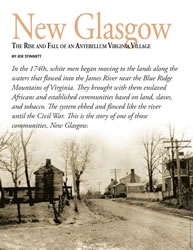New Glasgow



In the 1740s, white men began moving to the lands along the waters that flowed into the James River near the Blue Ridge Mountains of Virginia. They brought with them enslaved Africans and established communities based on land, slaves, and tobacco. The system ebbed and flowed like the river until the Civil War. This is the story of one of those communities, New Glasgow.
The Early Years
Now called Clifford, New Glasgow was a thriving community by the first quarter of the nineteenth century, with taverns, schools, stores, a tanyard, a hotel, distilleries, a church, and even a race track. David S. Garland, whose Brick House still stands, was a member of the U.S. Congress, and served in the state legislature for more than twenty years. Garland was also the largest slave holder in Amherst County in 1810.
By then, the community already had transformed into a significant spot on the map. William Cabell, an Englishman, established the first large white presence during the 1730s and ’40s, claiming most of the land along the James River from today’s Nelson County upstream almost to Lynchburg.
Entire article available only in printed version. Lynch's Ferry is on sale at the following Lynchburg locations: Bookshop on the Avenue, Givens Books, Lynchburg Visitors Center, Old City Cemetery, Point of Honor, Market at Main, and Lynch's Ferry office at The Design Group, 1318 Church Street, Lynchburg.
Click here for Exclusive Online Content
Joe Stinnett is managing editor of The News & Advance in Lynchburg. A graduate of the University of Virginia, he grew up in Clifford on a farm that was part of the original Tusculum plantation.
The Early Years
Now called Clifford, New Glasgow was a thriving community by the first quarter of the nineteenth century, with taverns, schools, stores, a tanyard, a hotel, distilleries, a church, and even a race track. David S. Garland, whose Brick House still stands, was a member of the U.S. Congress, and served in the state legislature for more than twenty years. Garland was also the largest slave holder in Amherst County in 1810.
By then, the community already had transformed into a significant spot on the map. William Cabell, an Englishman, established the first large white presence during the 1730s and ’40s, claiming most of the land along the James River from today’s Nelson County upstream almost to Lynchburg.
Entire article available only in printed version. Lynch's Ferry is on sale at the following Lynchburg locations: Bookshop on the Avenue, Givens Books, Lynchburg Visitors Center, Old City Cemetery, Point of Honor, Market at Main, and Lynch's Ferry office at The Design Group, 1318 Church Street, Lynchburg.
Click here for Exclusive Online Content
Joe Stinnett is managing editor of The News & Advance in Lynchburg. A graduate of the University of Virginia, he grew up in Clifford on a farm that was part of the original Tusculum plantation.
^ Top
Previous page: Fall 2008
Next page: New Glasgow Bibliography
Site Map




